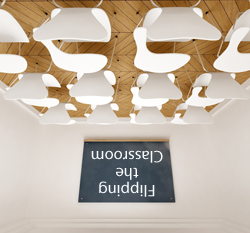 This month our Innovators session is covering a hot topic in the education space – the flipped classroom. The presenters are from California State University, Northridge (CSUN) and include Jodi Brown, Ph. D.; Wendy Ashley, Psy.D./LCSW; and Li Wang, Ph. D. Brown and Ashley are both faculty members in the Department of Social Work at CSUN and Wang is an instructional designer for the Faculty Technology Center. These educators have adopted the flipped classroom model and plan to implement it in their courses for the 2012-2013 school year. Learn more about the process of developing a flipped classroom with SoftChalk by reading the interview below and signing up for the Innovators in Online Learning Session, which will take place August 13th at 4:00PM EDT.
This month our Innovators session is covering a hot topic in the education space – the flipped classroom. The presenters are from California State University, Northridge (CSUN) and include Jodi Brown, Ph. D.; Wendy Ashley, Psy.D./LCSW; and Li Wang, Ph. D. Brown and Ashley are both faculty members in the Department of Social Work at CSUN and Wang is an instructional designer for the Faculty Technology Center. These educators have adopted the flipped classroom model and plan to implement it in their courses for the 2012-2013 school year. Learn more about the process of developing a flipped classroom with SoftChalk by reading the interview below and signing up for the Innovators in Online Learning Session, which will take place August 13th at 4:00PM EDT.
Q: How does CSUN define the flipped classroom model?
A: Faculty Technology Center (FTC): We define the flipped classroom as taking lectures out of the classroom and replacing them with value-added, interactive activities such as discussions, working practice problems, team-based exercises, etc. This enables students to “rewind the instructor” and watch the lecture outside of class as many times as desired from any device, which presumably increases retention and comprehension.
Q: Why did you decide to move to this approach?
A: Jodi Brown (JLB): The Department of Social Work at CSUN is launching an online program in the fall so all of our courses need to be available to students off-site.
A: Wendy Ashley (WA): We found that developing courses around traditional methods that worked in the classroom were too “flat” and not engaging enough for an online program. With SoftChalk we were able to create interactive activities and lectures that added a level of depth to our course development. Further, SoftChalk materials have been helpful in adding more interactive elements to our in class program as well, which we were not anticipating.
Q: How many programs at CSUN are following the Flipped Classroom model?
A: WA: I am not sure, since I believe the definition of a flipped classroom is different across the departments.
A: FTC: Flipping is so new that we don’t have concrete statistics yet; however, based on interest and growing demand for video and lecture capture services, we can tell that it is growing rapidly.
Q: What are the advantages of a flipped classroom?
A: WA: It seems like the most obvious advantage is the interactive, exciting presentation of the material. Since we have done more creating and less “doing,” our information is limited. I am hopeful that the students find the model engaging and are motivated to pay more attention and absorb the material more comprehensively.
Q: Are there any disadvantages or challenges?
A: WA: We have limited information until we actually teach using a flipped classroom model (our program launches this fall). However, I will say that there is somewhat of a learning curve in learning a new way to teach.
Q: How has SoftChalk been helpful with implementing the flipped classroom?
A: JLB: I tested one of my online modules with students in my current class. They reported liking the interactivity of SoftChalk compared to my usual Powerpoint lectures and asked for access for the modules so they can review the material at their leisure.
A: WA: I feel like SoftChalk added an element of interest and made my modules more three dimensional, vs the two dimensional modules with PowerPoint alone.
To learn more about Flipping the Classroom with SoftChalk, watched the recorded Innovators in Online Learning Session.

One Comment
Evelyn Wesely
If you REALLY want something nice, you might want to consider Fort DeSoto County Park in southern Pinellas County (Tampa Bay area).